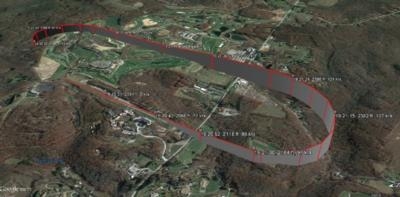Three Fatally Injured When Beech Bonanza Went Down In Pennsylvania
The NTSB has released a probable cause report from an accident which occurred in December, 2015 that resulted in the fatal injury of a pilot and two passengers aboard an A36 Bonanza. The board said that a cabin door came open shortly after takeoff, which led to loss of control of the airplane.

According to the report, the private pilot and two passengers were departing on a cross-country flight. Witness statements and data from an onboard GPS indicated that, after takeoff, the airplane turned left and entered the downwind leg of the airport traffic pattern for the departure runway. The airplane climbed to a maximum altitude about 500 ft above ground level (agl), then entered a gradual descent as it continued downwind and entered a left base leg. Witnesses noted that the landing gear was extended. The final data points from the GPS indicated that the airplane was conducting a tight turn from the base to final legs of the traffic pattern at a low airspeed and an altitude about 200 ft agl. The airplane crashed in a heavily wooded area near a golf course. It is likely that, during the final turn, the airplane exceeded its critical angle of attack and experienced an aerodynamic stall. A passenger, who was severely burned but able to egress the airplane following the accident, advised first
responders that the cabin door had opened just after takeoff.
Examination of the wreckage revealed no evidence of any mechanical malfunction of the airplane or engine prior to the accident. The forward cabin door's upper latching mechanism (hook) was not fully extended; the slot in the upper fuselage frame, which the hook engaged when the door was closed, showed no evidence of tear-outs; and the door handle mechanism was not fully in the locked position. These findings are consistent with the cabin door being open at the time of impact.
The airplane's pilot's operating handbook (POH) advised that the forward cabin door could unlatch in flight if not properly secured; this could occur during or just after takeoff. Although the door would open about 3 inches, the flight characteristics of the airplane would not be affected, with the exception of a reduced rate of climb. The POH advised that, if the door opened in flight, the pilot should "return to the field in a normal manner."
Twenty-two years before the accident flight, the airplane manufacturer published a mandatory service bulletin after receiving reports of the lower aft latch pin on the cabin door retracting in flight due to misrigging and/or vibration. When the latch pin retracted, it would force the entire door latching mechanism to reverse, allowing the door to open. This service bulletin, which had not been accomplished on the accident airplane, would have modified the forward cabin door to reduce the possibility of a cabin door opening in flight.
Toxicological testing on specimens from the pilot identified amphetamine at 0.310 ug/ml and 0.347 ug/ml in blood and 1.828 ug/ml in urine. This is well above any therapeutic range, which is less than 0.20 ug/ml. Generally, levels above 0.20 are the result of misusing amphetamine to maximize its psychoactive effects. In addition, phenylpropanolamine was detected in the pilot's urine, which suggests that he obtained the drug from non-pharmaceutical sources. An autopsy identified thickening of the heart walls and minimal coronary artery disease; however, this was unlikely to have caused acute symptoms. The thickening of the heart walls was likely caused by the increased workload related to repeated episodes of increased heart rate and blood pressure resulting from amphetamine use. It is possible that these two conditions (thickened heart and significant levels of amphetamine) combined to cause a sudden arrhythmia (a specific risk with amphetamine) which could have caused palpitations or fainting,
resulting in the pilot's loss of control of the airplane. Such an event would not have left evidence that could be identified on autopsy.
It could not be determined whether the pilot was experiencing the euphoria of early phase response to amphetamine or the dysphoria of coming down from its effects. In either case, the effects are significantly impairing and affect the ability to concentrate, make safe decisions, and perform.
Regardless of the reason the door opened in flight, the airplane should have remained airworthy and controllable. Although the pilot was attempting to return to land as prescribed by the POH following a door opening event, he did not safely manage the airplane's airspeed and angle of attack and lost control of the airplane. The investigation could not determine whether the pilot's impaired judgement or an acute arrhythmia caused by his misuse of amphetamine led to his inability to safely land the airplane; however, in either case, the pilot's misuse of amphetamine contributed to the accident.
The National Transportation Safety Board determines the probable cause(s) of this accident to be the pilot's failure to maintain control of the airplane after a cabin door came open in flight, which resulted in the airplane exceeding its critical angle of attack and experiencing an aerodynamic stall. Contributing to the accident was the pilot's misuse of amphetamine.
(Source: NTSB. Image from probable cause report)
 SpaceX to Launch Inversion RAY Reentry Vehicle in Fall
SpaceX to Launch Inversion RAY Reentry Vehicle in Fall Aero-News: Quote of the Day (04.23.24)
Aero-News: Quote of the Day (04.23.24) Aero-News: Quote of the Day (04.20.24)
Aero-News: Quote of the Day (04.20.24) ANN's Daily Aero-Linx (04.20.24)
ANN's Daily Aero-Linx (04.20.24) Aero-News: Quote of the Day (04.21.24)
Aero-News: Quote of the Day (04.21.24)



